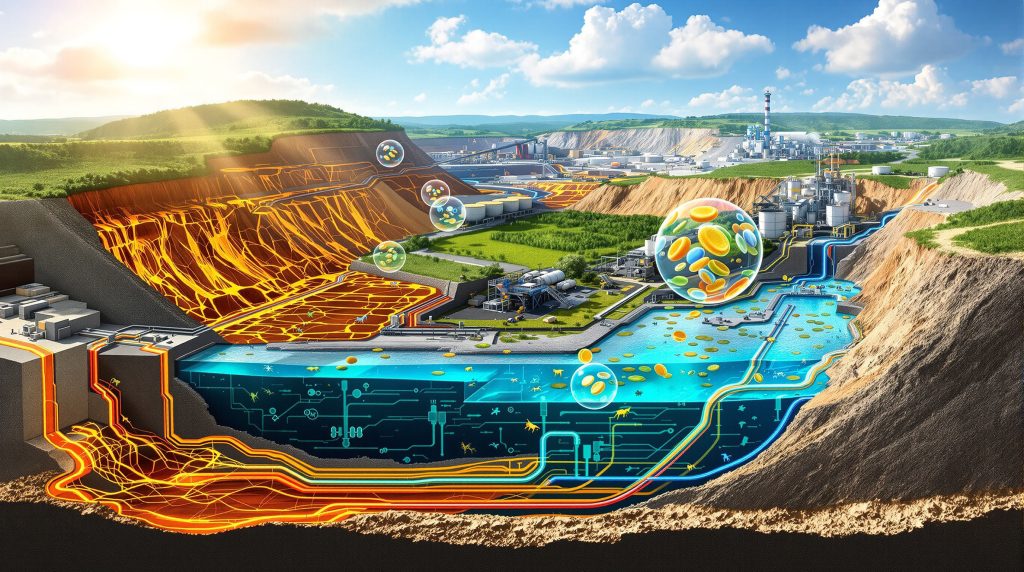Understanding the Chemical Foundation of Environmental Mining Challenges
Acid and metalliferous drainage management represents one of the most significant environmental challenges facing the modern mining industry. This complex phenomenon occurs when sulfide minerals in mining waste react with oxygen and water, creating acidic solutions that can mobilize heavy metals and persist in the environment for decades or even centuries. The environmental and economic implications of inadequately managed acid and metalliferous drainage extend far beyond individual mining operations, affecting entire watersheds and requiring substantial financial resources for remediation.
The formation process begins at the molecular level when pyrite and other sulfide minerals become exposed to atmospheric conditions during mining operations. These reactions produce sulfuric acid and dissolved metals, creating drainage that can severely impact aquatic ecosystems and groundwater quality. Understanding this fundamental chemistry provides the foundation for developing effective prevention and treatment strategies that can protect environmental resources while maintaining economically viable mining operations.
Recent advances in acid and metalliferous drainage management have shifted industry focus toward integrated approaches that combine source control, active treatment, and passive remediation systems. This evolution reflects growing recognition that successful management requires comprehensive planning from initial mine design through post-closure monitoring, with particular emphasis on preventing acid generation rather than treating contaminated water after problems develop.
The Science Behind Sulfide Mineral Oxidation
The chemical reactions responsible for acid and metalliferous drainage follow predictable pathways that mining professionals can model and predict with increasing accuracy. When pyrite (FeS₂) encounters oxygen and water, it undergoes a series of oxidation reactions that produce sulfuric acid, ferrous iron, and sulfate ions. These initial reactions create conditions that favour additional oxidation processes, establishing a self-perpetuating cycle that can continue long after active mining ceases.
Bacterial catalysis plays a crucial role in accelerating these chemical processes. Acidithiobacillus ferrooxidans and other iron-oxidising bacteria can increase reaction rates by several orders of magnitude compared to purely chemical oxidation. These microorganisms thrive in acidic environments and actually benefit from the conditions they help create, leading to exponential increases in acid production rates under favourable circumstances.
Environmental factors significantly influence the severity and duration of acid generation. Temperature fluctuations, moisture availability, oxygen infiltration rates, and seasonal precipitation patterns all affect the kinetics of sulfide oxidation. Understanding these variables enables mining engineers to design waste storage facilities that minimise exposure of reactive materials to oxidising conditions.
Critical Factors in Drainage Development
Mineral composition serves as the primary determinant of acid generation potential. Materials with high sulfur content, particularly those containing pyrite, pyrrhotite, or chalcopyrite, pose the greatest risk for acid production. However, the presence of alkaline minerals such as calcite or dolomite can neutralise acid production, creating complex geochemical interactions that require detailed characterisation for accurate prediction.
Hydrogeological conditions control how water moves through waste materials, affecting both the rate of oxidation reactions and the transport of acidic drainage. Factors such as porosity, permeability, and groundwater flow patterns determine whether acid generation remains localised or spreads throughout larger areas. Climate considerations, including precipitation intensity and evaporation rates, influence the volume and concentration of drainage that mining operations must manage.
Particle size distribution in waste materials affects both oxygen infiltration and water retention characteristics. Finely crushed materials typically exhibit higher reaction rates due to increased surface area exposure, while larger particles may create preferential flow paths that concentrate oxidation in specific zones. These physical characteristics interact with chemical properties to determine overall acid generation potential.
Proactive Prevention Through Strategic Mine Design
Source control represents the most cost-effective approach to acid and metalliferous drainage management, focusing on preventing acid generation rather than treating contaminated water. Furthermore, modern mine planning incorporates selective waste placement techniques that allow mining operations to segregate high-sulfur materials from benign waste rock, reducing overall oxidation potential while maintaining operational efficiency. This approach requires detailed geological characterisation during exploration phases to identify materials that require special handling.
Underwater storage systems provide highly effective acid prevention for high-risk tailings materials. By maintaining saturated conditions, these systems limit oxygen availability and effectively prevent sulfide oxidation. Subaqueous disposal has proven successful at numerous mining operations worldwide, though implementation requires careful attention to dam design, water quality monitoring, and long-term stability considerations.
Engineered cover systems offer another proven approach to source control, utilising multilayer designs that limit oxygen infiltration while managing surface water drainage. These covers typically incorporate low-permeability barriers, capillary break layers, and vegetation establishment to create long-term protection for reactive waste materials. Advanced cover designs can achieve oxygen flux reductions exceeding 95%, effectively preventing acid generation for decades.
Predictive Testing and Characterisation Methods
Static testing protocols provide initial screening for acid generation potential using established methods such as acid-base accounting and net acid generation testing. These procedures quantify the balance between acid-producing sulfur minerals and neutralising alkaline minerals, generating acid generation potential values that guide waste management decisions. While static tests offer valuable baseline information, they cannot predict reaction kinetics or long-term behaviour patterns.
Kinetic testing programmes utilise humidity cell tests, column leaching experiments, and other dynamic procedures to simulate long-term weathering processes. These extended testing programmes, often lasting several years, provide data on reaction rates, metal leaching patterns, and treatment requirements for different waste materials. Results from kinetic testing support mine planning decisions and regulatory approval processes while providing baseline data for monitoring programmes.
Integration of testing results into mine planning requires sophisticated modelling approaches that consider spatial variability, temporal changes, and operational constraints. Advanced software platforms now enable three-dimensional visualisation of acid generation risk throughout mining operations, supporting optimal waste placement strategies and closure planning decisions.
Chemical Treatment Technologies and Applications
Lime-based neutralisation systems represent the most widely implemented active treatment approach for acid and metalliferous drainage management. These systems utilise calcium hydroxide or calcium oxide to raise pH levels and precipitate dissolved metals as hydroxide compounds. The process typically achieves pH targets between 8.5 and 9.5, ensuring effective metal removal while generating manageable sludge volumes for disposal.
| Treatment Parameter | Lime Neutralisation | Caustic Soda | Limestone | Sulfide Precipitation |
|---|---|---|---|---|
| Optimal pH Range | 8.5-9.5 | 9.0-10.0 | 6.5-7.5 | 7.0-8.0 |
| Metal Removal Rate | 95-99% | 90-95% | 70-85% | 99%+ |
| Reagent Cost Level | Moderate | High | Low | High |
| Sludge Production | High | High | Moderate | Low |
High-density sludge systems enhance treatment efficiency by recycling previously precipitated solids to seed new precipitation reactions. This approach reduces chemical consumption, minimises sludge production, and improves settling characteristics of precipitated metals. Modern high-density sludge plants can achieve metal removal efficiencies exceeding 99% while reducing sludge volumes by 50% compared to conventional treatment systems.
Alternative neutralising agents offer specific advantages under certain operating conditions. Sodium hydroxide provides rapid pH adjustment and minimal sludge production but involves higher chemical costs. Magnesium hydroxide offers selective metal removal capabilities and reduced chemical consumption in some applications. Ammonia-based systems can achieve effective treatment while producing potentially saleable ammonium sulfate as a byproduct.
Advanced Active Treatment Innovations
Sulfide precipitation technology represents a significant advancement in selective metal removal from contaminated drainage. This process utilises hydrogen sulfide or other sulfide sources to precipitate metals as sulfide compounds, which exhibit extremely low solubility and superior stability compared to hydroxide precipitates. Sulfide precipitation systems can achieve metal concentrations below detection limits while producing high-grade metal sulfide concentrates suitable for metal recovery.
Selective metal recovery systems enable mining operations to extract valuable metals from acid drainage streams, transforming environmental liabilities into revenue-generating resources. Advanced precipitation and separation techniques can recover copper, zinc, nickel, and other metals in concentrated forms suitable for resale to metal refineries. These systems require higher capital investments but can generate substantial long-term economic returns while achieving superior environmental protection.
Membrane technologies, including reverse osmosis and nanofiltration, offer highly effective water purification capabilities for complex drainage compositions. These systems can achieve extremely low metal concentrations in treated effluent while producing concentrated brine streams suitable for further metal recovery. Membrane systems typically require significant energy inputs but provide exceptional treatment reliability and minimal chemical consumption.
Natural Treatment Through Biological Systems
Constructed wetland systems harness natural biological processes to treat acid and metalliferous drainage through metal precipitation, adsorption, and plant uptake mechanisms. These passive treatment systems utilise carefully designed substrate materials, vegetation selection, and hydraulic controls to create optimal conditions for metal removal and acid neutralisation. Well-designed constructed wetlands can operate effectively for decades with minimal maintenance requirements.
In addition, sulfate-reducing bacteria applications utilise anaerobic microorganisms to reduce sulfate ions while generating alkalinity and precipitating metals as sulfide minerals. These biological systems require organic carbon sources and controlled anaerobic conditions but can achieve excellent treatment performance while producing stable metal precipitates. Bacterial sulfate reduction systems work particularly well in combination with constructed wetlands or other passive treatment approaches.
Long-term Performance Insight: Passive treatment systems can maintain effective operation for 20-30 years or longer with appropriate design and periodic maintenance, making them ideal solutions for post-closure water management scenarios where perpetual active treatment would be economically prohibitive.
Biofilm reactors concentrate sulfate-reducing bacteria in controlled environments, achieving higher treatment rates than conventional wetland systems while maintaining passive operation characteristics. These systems utilise packed bed reactors with organic substrate additions to support bacterial growth and metal precipitation. Biofilm reactors can handle higher contaminant loadings than wetlands while requiring smaller physical footprints.
Innovative Geochemical Treatment Methods
Permeable reactive barriers provide in-situ groundwater treatment using reactive media such as zero-valent iron, limestone, or organic substrates. These systems intercept contaminated groundwater plumes and treat them as they flow through engineered reactive zones. Permeable reactive barriers offer long-term treatment capability with minimal operational requirements, though they require careful design to ensure adequate residence time and reactive media longevity.
Limestone drainage systems utilise natural alkalinity generation to neutralise acidic drainage while precipitating dissolved metals. These systems require careful sizing to ensure adequate neutralisation capacity and may incorporate multiple stages to optimise treatment efficiency. Open limestone channels work well for moderately acidic drainage, while anoxic limestone drains can treat more severely acidic waters by limiting aluminium precipitation that can reduce system effectiveness.
Organic substrate systems enhance metal removal through both chemical reduction and biological processes. Materials such as wood chips, sawdust, or agricultural waste provide carbon sources for bacterial growth while creating reducing conditions that favour metal sulfide precipitation. These systems typically require periodic substrate replacement but offer cost-effective treatment for many drainage compositions.
Integrated Management Throughout Mining Lifecycles
Comprehensive lifecycle management approaches recognise that effective acid and metalliferous drainage management begins during exploration phases and continues through post-closure monitoring. Pre-mining risk assessment protocols now incorporate detailed geological characterisation, waste rock testing programmes, and predictive modelling to identify potential acid generation issues before they develop. This proactive approach enables mining operations to implement prevention measures during initial design phases when they are most cost-effective.
Operational monitoring systems utilise real-time water quality sensors, automated sampling equipment, and data management platforms to track drainage chemistry changes and system performance. Advanced monitoring approaches incorporate weather data, groundwater levels, and treatment system parameters to provide comprehensive understanding of acid and metalliferous drainage behaviour. Early warning systems can alert operators to developing problems before they require emergency response measures.
However, closure planning requirements now mandate detailed acid and metalliferous drainage management plans that address long-term water quality protection, financial assurance, and institutional controls. These plans must demonstrate sustainable management approaches that can continue indefinitely without ongoing operational support. Regulatory agencies increasingly require performance guarantees and adaptive management frameworks that can respond to changing conditions over time.
Regulatory Frameworks and Industry Standards
International guidelines from organisations such as the International Network for Acid Prevention provide technical standards and best practice recommendations for acid and metalliferous drainage management. These guidelines address prediction methods, prevention strategies, treatment technologies, and monitoring requirements while incorporating lessons learned from projects worldwide. Industry adoption of these standards helps ensure consistent management approaches and regulatory compliance across different jurisdictions.
Environmental monitoring requirements typically mandate regular sampling of surface water, groundwater, and biological resources to assess management system effectiveness. Monitoring programmes must demonstrate compliance with water quality standards while providing early detection of system performance changes. Data management requirements increasingly emphasise public access to monitoring information and long-term trend analysis capabilities.
Stakeholder engagement processes recognise that local communities, environmental groups, and regulatory agencies have legitimate interests in acid and metalliferous drainage management decisions. Effective engagement programmes provide transparent information about management approaches, monitoring results, and long-term commitments while incorporating community concerns into management planning processes.
Technological Innovation and Digital Integration
Remote sensing technologies now enable comprehensive monitoring of mine waste storage facilities using satellite imagery, aerial photography, and unmanned aerial vehicle platforms. These systems can detect surface changes, vegetation stress, and seepage patterns that may indicate developing acid and metalliferous drainage problems. Advanced image processing techniques can identify subtle changes over time, supporting early intervention strategies.
Machine learning applications analyse complex datasets from monitoring programmes to identify patterns and predict future drainage chemistry changes. These analytical tools can process weather data, water quality measurements, and operational parameters to forecast treatment requirements and optimise system performance. Artificial intelligence systems show particular promise for managing the vast datasets generated by modern monitoring programmes.
Real-time monitoring networks utilise wireless sensor technologies and satellite communications to provide continuous data on drainage quality and treatment system performance. These systems enable immediate response to changing conditions while reducing the costs and risks associated with manual sampling programmes. Integration with automated treatment systems allows for responsive management that optimises performance while minimising operational costs.
Emerging Treatment Technologies
Electrochemical treatment methods utilise electrical current to precipitate metals and adjust pH levels in contaminated drainage. These systems offer precise control over treatment processes while potentially recovering valuable metals in concentrated forms. Electrocoagulation and electroflotation processes show particular promise for treating complex drainage compositions with multiple dissolved metals.
Advanced oxidation processes apply powerful oxidising agents to break down organic complexes and modify metal speciation in drainage streams. These technologies can enhance downstream treatment effectiveness while addressing specific contaminants that resist conventional treatment approaches. Ozone, hydrogen peroxide, and ultraviolet radiation systems offer different capabilities for specialised applications.
Hybrid treatment systems combine active and passive approaches to optimise performance while minimising operational requirements. These systems might utilise active treatment for initial contamination control followed by passive polishing systems for long-term maintenance. Hybrid approaches can achieve superior treatment performance while reducing lifecycle costs compared to purely active or passive alternatives.
Economic Analysis and Cost Optimisation Strategies
Capital cost comparisons between different management approaches reveal significant variations depending on site-specific conditions and performance requirements. Prevention strategies typically require higher initial investments but generate substantial savings over project lifecycles by avoiding perpetual treatment costs. Active treatment systems involve moderate capital costs but substantial ongoing operational expenses, while passive systems require higher initial investment but minimal long-term operating costs.
Life-cycle cost analysis must consider treatment system longevity, performance reliability, and future replacement requirements. Systems designed for 20-year operating lives may require complete reconstruction multiple times during extended post-closure periods. Financial modelling increasingly incorporates uncertainty analysis and risk assessment to account for changing regulatory requirements and performance variability over time.
Cost-benefit evaluation frameworks help mining operations compare prevention investments against potential treatment costs and environmental liabilities. These analyses must consider regulatory compliance costs, environmental bonding requirements, and potential legal liabilities associated with inadequate management. Prevention strategies often demonstrate superior economic returns when evaluated over complete mine lifecycles including post-closure periods.
Successful Implementation Examples
Mining operations worldwide have demonstrated successful acid and metalliferous drainage management using integrated approaches tailored to site-specific conditions. Successful projects typically combine comprehensive characterisation, appropriate prevention measures, and adaptive management strategies that can respond to changing conditions over time. These case studies provide valuable guidance for developing management approaches at new operations.
Performance data from established treatment systems offer insights into long-term effectiveness and operational requirements for different technologies. Well-documented projects provide baseline information for cost estimation and performance prediction while identifying common implementation challenges and solutions. This information database continues growing as more projects reach operational maturity and closure phases.
Regional variations in regulatory requirements, climate conditions, and geological characteristics influence optimal management approaches for different locations. Arctic operations face unique challenges related to seasonal temperature variations and permafrost conditions, while tropical operations must address intense precipitation events and elevated biological activity rates. Understanding these regional factors helps optimise management strategies for local conditions.
Future Directions in Sustainable Resource Recovery
Circular economy principles increasingly influence acid and metalliferous drainage management by emphasising resource recovery and waste minimisation. Mining operations now evaluate opportunities to extract valuable metals from drainage streams, convert waste materials into useful products, and integrate management systems with broader sustainability objectives. These approaches can transform environmental liabilities into economic assets while achieving superior environmental protection.
Critical mineral recovery from mine waste and drainage streams represents an emerging opportunity as global demand increases for materials essential to renewable energy technologies. Rare earth elements, lithium, cobalt, and other critical minerals present in some drainage streams may justify advanced recovery systems that provide both environmental protection and economic returns. Research continues into cost-effective extraction methods for these specialised applications.
Integration with renewable energy systems offers potential for powering treatment systems using solar, wind, or other sustainable energy sources. Remote mining locations often have excellent renewable energy resources that can support treatment system operations while reducing operational costs and environmental impacts. Energy storage systems enable continuous treatment system operation despite intermittent renewable energy availability.
Research and Development Frontiers
Biotechnology applications explore engineered microorganisms and enzyme systems for enhanced treatment performance and selective metal recovery. Genetically modified bacteria might offer improved sulfate reduction rates, enhanced metal tolerance, or specific metal sequestration capabilities. Enzyme-based treatment systems could provide precise control over chemical reactions while minimising energy requirements.
Nanotechnology solutions investigate engineered nanomaterials for selective metal adsorption, advanced membrane performance, and targeted remediation applications. Nanoparticle systems might offer superior performance for specific contaminants while enabling recovery and reuse of treatment materials. Carbon nanotubes, metal oxides, and other nanomaterials show promise for specialised treatment applications.
Climate adaptation strategies address how changing precipitation patterns, temperature regimes, and extreme weather events will affect acid and metalliferous drainage management systems. Management plans must consider potential changes in acid generation rates, treatment system performance, and water balance conditions over extended time periods. Adaptive management frameworks provide mechanisms for modifying systems as climate conditions evolve.
Industry Evolution and Innovation Integration
The mining industry evolution continues to drive advances in acid and metalliferous drainage management through technological innovation and regulatory developments. Modern approaches increasingly emphasise integration of mining decarbonisation benefits with environmental protection strategies, creating synergies between climate action and water quality objectives. This convergence reflects broader sustainability trends that recognise environmental management as a competitive advantage rather than merely a compliance requirement.
Furthermore, mine reclamation innovation plays an essential role in long-term acid and metalliferous drainage management by establishing sustainable landforms and vegetation systems that complement engineered treatment solutions. These integrated approaches demonstrate how comprehensive environmental planning can achieve superior outcomes while reducing long-term management costs.
The industry must also address emerging challenges such as deep sea mining concerns that highlight the importance of proven environmental management techniques for novel mining environments. These developments underscore the value of robust acid and metalliferous drainage management approaches that can adapt to diverse operational contexts.
Disclaimer: This article discusses emerging technologies and future trends that involve predictions and assumptions. While based on current research and industry developments, actual outcomes may vary significantly. Readers should consult qualified professionals and conduct site-specific evaluations before implementing any management strategies discussed in this article.
Essential Questions for Mining Professionals
What distinguishes acid rock drainage from metalliferous drainage in practical applications?
Acid rock drainage specifically involves pH reduction below 6.0 due to sulfide mineral oxidation, while metalliferous drainage can occur at neutral pH conditions with elevated dissolved metal concentrations. Both conditions can occur simultaneously, requiring comprehensive characterisation and management approaches.
How long might acid and metalliferous drainage persist after mining operations cease?
Drainage generation can continue for centuries depending on waste material composition, storage conditions, and climate factors. Some historic mining areas continue producing acidic drainage more than 100 years after operations ended, highlighting the importance of effective prevention strategies.
Which prevention approaches provide the most cost-effective long-term protection?
Source control through selective waste placement and engineered covers typically offers superior cost-effectiveness compared to perpetual treatment systems. Underwater storage provides excellent prevention for suitable materials, while properly designed covers can prevent acid generation for decades with minimal maintenance requirements.
The evolution of acid and metalliferous drainage management reflects the mining industry's growing sophistication in environmental protection and sustainable resource development. Modern approaches integrate advanced scientific understanding with proven engineering solutions to prevent problems rather than treat them after they develop. Success requires comprehensive planning, appropriate technology selection, and long-term commitment to environmental stewardship.
Future developments in this field will likely emphasise resource recovery opportunities, technological innovation, and adaptive management strategies that can respond to changing environmental and regulatory conditions. As mining operations face increasing scrutiny regarding environmental performance, effective acid and metalliferous drainage management becomes essential for maintaining social licence to operate while protecting valuable water resources for future generations.
Looking to Invest in Mining Companies with Strong Environmental Practices?
Discovery Alert's proprietary Discovery IQ model delivers real-time alerts on significant ASX mineral discoveries, helping subscribers identify companies implementing innovative environmental management strategies like advanced drainage treatment systems. Visit Discovery Alert's dedicated discoveries page to explore how major mineral discoveries can generate substantial returns, then begin your 30-day free trial to position yourself ahead of the market.




